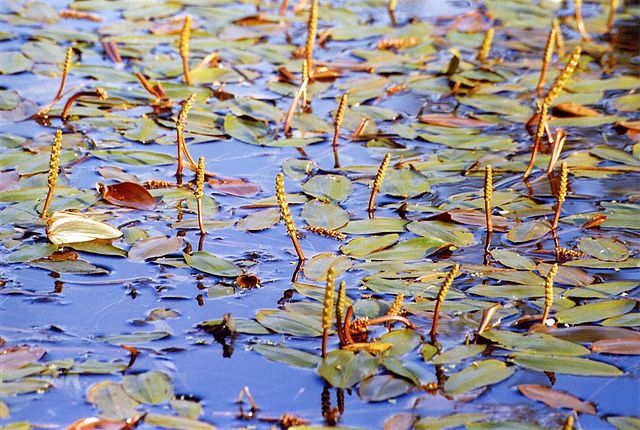 |  |  |  |  |
 |  |
Broad-leaved Pondweed is a perennial aquatic plant that prefers to grow in fresh water or slightly salty water. The plant attaches itself to the ground and floats on the surface of the water with the help of long shoots. The rhizome is branched and creeping. Rhizome knots, like gum, become fatter as autumn approaches.
The stem is thick, filled with air-containing tissue to ensure its buoyancy. It can be branched or unbranched. The stem is circular in cross-section and can grow up to 150 cm in length. On the stem are underwater leaves on long petioles. At the top are leaves that float on top of the water.
Submerged leaves have no leaf blade, alternate, linear or lanceolate, sometimes completely reduced. The length of the leaf can be up to half a meter. They are formed in the spring and completely disintegrate during the flowering of the plant.
The above-water leaves of the Broad-leaved Pondweed are brownish-green in color, thick, leathery, elongated or oval. A heart-shaped slit at the base. Pointed or blunt at the tip. Floating leaves are 7-13cm long and 5-8cm wide. Placed alternately on long petioles.
The flower stalks are 5-12 cm long and raised high above the water. Spike-shaped inflorescences 4-6 cm long are located on them. The flowers are small, inexpressive, greenish, bisexual, pollinated by the wind. The plant blooms in June-July. During flowering, all underwater leaves of the plant disappear.
The fruit is an inverted oval nut with a short "nose". The seeds ripen in July-August. The seeds can remain on the surface of the water for a long time and move with the water current over long distances.
The leaves are collected throughout the summer from July to August. After harvesting, the leaves are thoroughly washed, freed from debris and then dried in a shaded and well-ventilated area. The drug is packed in paper bags and stored in a dry, dark place for no longer than one year.
At the moment, the chemical composition of Broad-leaved Pondweed is insufficiently studied. However, it is known that the plant contains a lot of tannins, rhodoxanthin, ascorbic acid, some types of flavonoids and alkaloids.
Medicinal significance
The leaves are collected throughout the summer from July to August. After harvesting, the leaves are thoroughly washed, freed from debris and then dried in a shaded and well-ventilated area. The drug is packed in paper bags and stored in a dry, dark place for no longer than one year.
At the moment, the chemical composition of Broad-leaved Pondweed is insufficiently studied. However, it is known that the plant contains a lot of tannins, rhodoxanthin, ascorbic acid, some types of flavonoids and alkaloids.
Although the chemical composition of the plant has been little studied, it is able to bring its benefits to humans! For example, the ascorbic acid in the plant is an excellent tool for strengthening the immune system and blood vessel walls. Flavonoids activate digestive enzymes and have anti-bleeding and anti-inflammatory properties.
Since the plant has not been studied, it is not widely used in folk medicine either. Uses lessons learned from the past and uses decoctions of the plant to regulate digestion (prevent colic), use as an anti-inflammatory and astringent.
The plant is also used externally to treat skin inflammations, abscesses, boils, scabies and skin itching. Wounds are rinsed with a decoction of Broad-leaved Pondweed , burns are treated. Compresses of the decoction are used on painful joints and treat sprains, bruises, fractures and sprains.
